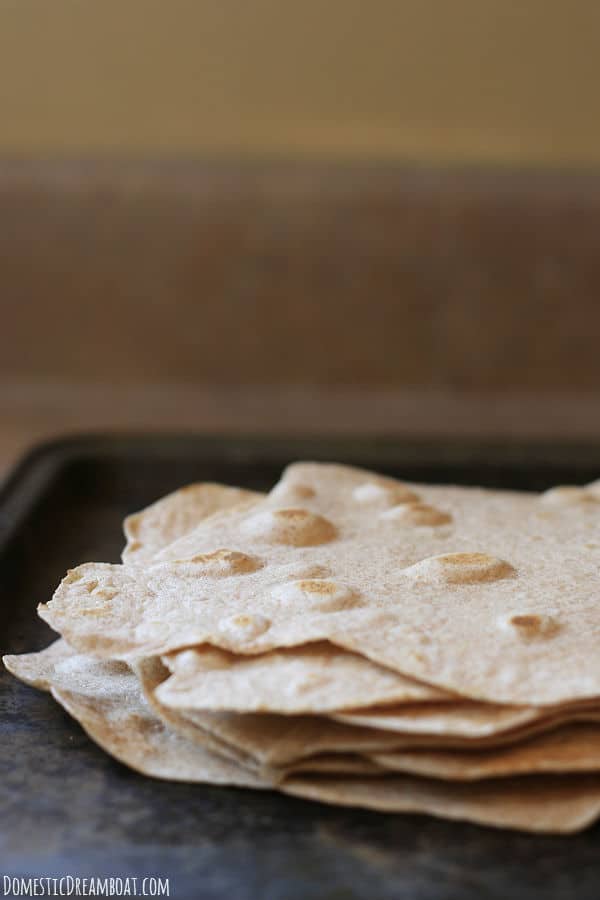Skillet Flatbread
This Skillet Flatbread is soft and chewy, and makes a great side dish or sandwich. It’s cooked in a skillet without having to heat up the oven!
When I make any kind of saucy main dish, whether it’s a stew or something like a curry, I like to have some kind of bread to dip in it. Sometimes that bread might be focaccia, or maybe slices of sourdough, but you can never go wrong with a good flatbread.
I’ve been making this Skillet Flatbread for several years, and my family has always loved it. And I like making it. It doesn’t take that long (for bread), and I don’t need to heat up the oven to make it, as it’s completely cooked on the stovetop. This comes in very handy in the summer. I made it most recently with my butter paneer, which my family has been loving lately.

How to Make Skillet Flatbread
Making this soft, chewy skillet flatbread starts with making the dough. I like to use my stand mixer to make mine, but you can use a food processor or knead it by hand instead.
Start by stirring together the dry ingredients (both flours, yeast, and salt) in the bowl of the stand mixer. In a separate bowl or large measuring cup, mix together the milk, yogurt, and olive oil.
Pour the wet ingredients into the bowl with the dry ingredients and stir by hand just until the liquid is incorporated. Turn the stand mixer (fitted with a dough hook) on to low speed and mix until the dough forms a smooth ball and no longer sticks to the bowl.
Transfer the dough to a clean countertop, and knead by hand a few times until the dough forms a ball. Place the dough into a lightly oiled bowl and cover it with a lid, plate, damp towel, or plastic wrap. Set the bowl in a warm spot to rise until doubled, 60-90 minutes.

After the dough has risen, punch it down and divide it into 6 equal pieces. Note that the most accurate way to do this is to weigh the whole piece of dough and divide that number by 6. Use a kitchen scale to measure out the 6 pieces of dough.
Heat a 10-inch skillet (preferably a well-seasoned cast iron skillet) over medium heat. Once hot, add a little oil and use a clean piece of paper towel to wipe the oil all over the skillet and remove any excess.
Working with one piece of dough at a time (keep the others covered in the meantime), roll the dough out into a 6-inch circle. Poke the dough all over with a fork, then lightly spray or brush a very thin layer of water over the top of the dough. Place the dough wet-side-down into the skillet and cover with a lid.
Cook the dough until there are browned spots on the bottom, about 4-5 minutes. Flip the dough and continue to cook, uncovered, until the bottom is browned in spots, about 2-3 more minutes. Adjust the temperature if needed during cooking if you notice the dough is browning too quickly or becoming too dark.
Transfer the flatbread to a wire rack and lightly brush one side with melted butter and sprinkle it with a small pinch of kosher salt. Repeat the above steps with the remaining pieces of dough, starting to prep the next piece of dough while the first cooks.
Serve the flatbread warm, keeping it hot in a low (200°F) oven if you plan to serve it right away, or you can reheat it in the microwave or toaster oven if needed.

Skillet Flatbread Ingredients
- Bread flour – I recommend using bread flour, not all-purpose flour, for this recipe to result in chewier flatbread
- Whole wheat flour – While I like to use some whole wheat flour in many of my bread and other baking recipes, it is not required. Simply replace it with an equal portion of bread flour if you don’t have any or don’t like whole wheat flour.
- Instant yeast – I recommend using instant yeast in most bread recipes simply because it’s easier. If you use active dry yeast instead, you will first need to proof it in some warm water with a little sugar.
- Table salt – If you use kosher salt instead of table salt for the dough, you will need to use a slightly larger volume (1 3/4 teaspoons instead of 1 1/2 teaspoons). However, if you measure by weight (which I recommend for baking), the measurement is the same for both.
- Milk – I used 1% milk, but you could use any milkfat percentage for this recipe
- Plain Greek yogurt – I recommend using 2% milkfat or higher for this flatbread. Using low-fat or fat-free yogurt will result in tougher flatbread.
- Olive oil – you will need this for both the dough and for oiling your skillet. You could use a neutral-flavored cooking oil instead of olive oil if you wish.
- Water – A little water (like a tablespoon, max) is needed to brush on the dough just before cooking. This creates a steamy environment in the skillet and helps to keep the flatbread soft, as opposed to crusty. Use whatever water you normally drink. Cold tap water is fine.
- Melted butter – This is used for brushing on the flatbread just after you take it out of the skillet. It helps keep the flatbread soft and adds buttery flavor.
- Kosher salt – I sprinkle a little pinch of kosher salt on the flatbreads just after I brush them with butter. You could skip this if you use salted butter or if you’re trying to keep your sodium intake down. I recommend kosher salt vs table salt for this because I find the texture better for sprinkling.

Want more flatbread recipes?
Skillet Flatbread Nutrition Notes
The nutrition information in the recipe below is for one piece of skillet flatbread if you use the recipe to make 6 pieces of bread.
To make your flatbread lower in fat and calories, skip brushing the bread with butter after cooking. To make it lower in sodium, skip sprinkling it with salt.
Equipment
Ingredients
Instructions
- Stir together 240 grams (2 cups) bread flour, 85 grams (¾ cups) whole wheat flour, 7 grams (2 ¼ teaspoons) instant yeast, and 9 grams (1 ½ teaspoons) table salt in the bowl of a stand mixer or a large bowl.
- In a smaller bowl or large measuring cup, stir together 227 grams (1 cup) milk, 57 grams (¼ cup) plain Greek yogurt, and 12 grams (2 Tablespoons) olive oil.
- Using a wooden spoon, dough whisk, or simply by holding the dough hook from your stand mixer, stir the milk mixture into the flour mixture until most of the liquid is incorporated.
- Fit the dough hook and the bowl onto the stand mixer and turn the mixer on to low speed. Mix until the dough forms a smooth ball and no longer sticks to the bowl (about 5-7 minutes).
- Knead the dough a few times by hand until it forms a ball. Place the dough into a lightly greased large bowl and cover with a lid, plate, damp towel, or plastic wrap. Let the dough rise until it's doubled (about 1-2 hours depending on the temperature of your kitchen and the milk you added to the dough).
- Punch the dough down and divide it into 6 equal pieces (the most accurate way to do this is to weigh the dough and divide the weight by 6, then weigh out each piece). Keep the dough balls covered with a clean, damp kitchen towel to prevent it from drying out.
- Heat a large skillet (preferably cast iron) over medium heat. Once it's hot, pour a small amount of oil (around 1 teaspoon) into the skillet, and carefully use a clean paper towel to wipe it around the skillet and remove the excess.
- Working with one piece of dough at a time, roll the dough into a circle (it should be roughly 6 inches). Use a fork to poke the dough all over to prevent any large bubbles from forming while cooking. Use a small spray bottle (make sure it's only ever been used for food-safe ingredients) or a silicone brush to brush a very thin layer of water over the top of the dough.
- Place the dough, wet side down, into the skillet and cover the skillet with a lid. Cook until the bottom of the dough is well-browned in spots (about 4-5 minutes), then flip and cook, uncovered, until the other side of the dough is browned, about 2-3 minutes. If you find the flatbreads are getting too dark, reduce the temperature (I find that I'm frequently adjusting between heat levels 4 and 5).
- Transfer the flatbread to a wire rack and immediately brush one side of it with melted butter and sprinkle with a small pinch of kosher salt. Keep the flatbreads warm in a low (200°F) oven, if you plan to serve them right away.
- Repeat with the remaining dough pieces, rolling out and prepping the next piece of dough while the previous one cooks, until all of the dough is cooked. Serve hot. If needed, reheat in a toaster oven or microwave before serving.
Nutrition
Tried this recipe?
Please Consider Leaving a Review!




